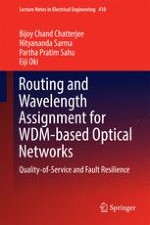This book presents an in-depth treatment of routing and wavelength assignment for optical networks, and focuses specifically on quality-of-service and fault resiliency issues. It reports on novel approaches for the development of routing and wavelength assignment schemes for fault-resilient optical networks, which improve their performance in terms of signal quality, call blocking, congestion level and reliability, without a substantial increase in network setup cost.
The book first presents a solution for reducing the effect of the wavelength continuity constraint during the routing and wavelength assignment phase. Further, it reports on an approach allowing the incorporation of a traffic grooming mechanism with routing and wavelength assignment to enhance the effective channel utilization of a given capacity optical network using fewer electrical-optical-electrical conversions. As a third step, it addresses a quality of service provision scheme for wavelength-division multiplexing (WDM)-based optical networks. Lastly, the book describes the inclusion of a tree-based fault resilience scheme in priority-based dispersion-reduced wavelength assignment schemes for the purpose of improving network reliability, while maintaining a better utilization of network resources.
Mainly intended for graduate students and researchers, the book provides them with extensive information on both fundamental and advanced technologies for routing and wavelength assignment in optical networks. The topics covered will also be of interest to network planners and designers.
